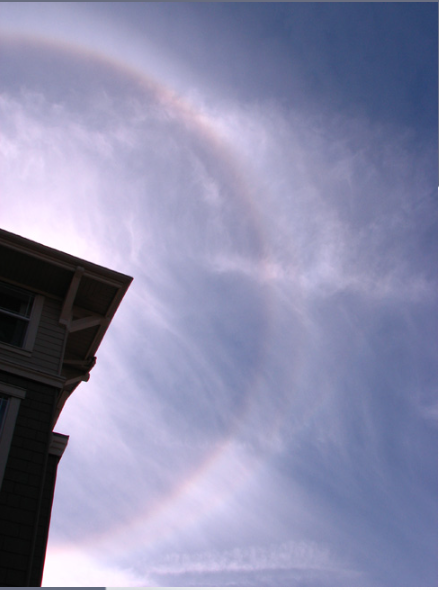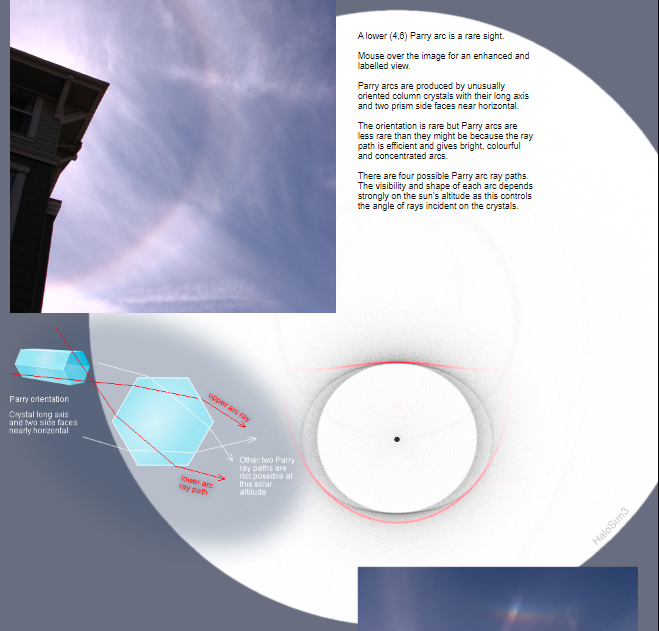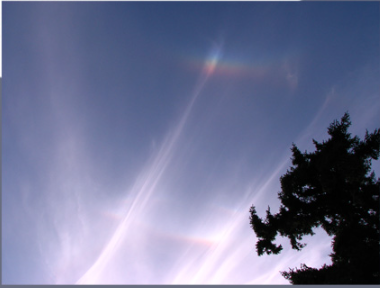BC Lower Parry Arc
BC Lower Parry Arc: A Rare and Captivating Atmospheric Phenomenon
Atmospheric optics never ceases to amaze us with its stunning displays of light and color. One such captivating phenomenon is the lower (4,6) Parry arc, a rare sight that leaves observers in awe. This optical marvel is produced by unusually oriented column crystals, where their long axis and two prism side faces are positioned near horizontal. Although the orientation of these crystals is rare, Parry arcs are not as uncommon as one might think. In fact, they are more frequent due to the efficient ray path they follow, resulting in bright, colorful, and concentrated arcs.
The visibility and shape of each Parry arc depend strongly on the sun's altitude, as this determines the angle at which rays incident on the crystals. There are four possible ray paths for Parry arcs, each offering a unique visual experience. Let's delve deeper into the fascinating world of BC Lower Parry arcs and explore the intricacies of their formation.
Understanding the Formation of BC Lower Parry Arcs
-
Unusual Crystal Orientation: BC Lower Parry arcs occur when column crystals align in a rare orientation, with their long axis and two prism side faces positioned horizontally. This specific arrangement allows for the creation of these captivating optical phenomena.
-
Efficient Ray Path: Despite their rarity, Parry arcs are more commonly observed due to the efficiency of the ray path they follow. The efficient trajectory results in bright and concentrated arcs that capture the attention of both casual observers and avid atmospheric optics enthusiasts.
-
Sun's Altitude and Arc Visibility: The visibility and shape of BC Lower Parry arcs are greatly influenced by the sun's altitude. As the sun's position changes throughout the day, so does the angle at which rays interact with the crystals, ultimately affecting the appearance of the arcs. Observing these arcs during different times of the day can provide varying visual experiences.
Exploring the Visual Characteristics of BC Lower Parry Arcs
-
Bright and Colorful Display: BC Lower Parry arcs are known for their vibrant and vivid colors. The interaction between sunlight and the aligned column crystals results in the dispersion of light, creating a mesmerizing display of hues ranging from reds and oranges to greens and blues.
-
Concentrated Arcs: Unlike some other atmospheric optical phenomena, BC Lower Parry arcs appear as distinct and concentrated arcs. Their well-defined shape adds to their visual appeal, making them a captivating subject for photographers and sky gazers alike.
-
Rare Sight: While Parry arcs in general are not as rare as their unusual crystal orientation might suggest, BC Lower Parry arcs remain relatively uncommon. Their scarcity adds an element of exclusivity to these optical wonders, making each sighting all the more special.
Capturing the Beauty of BC Lower Parry Arcs
Photographers and nature enthusiasts often seek to capture the beauty of atmospheric phenomena like BC Lower Parry arcs. To enhance the experience of observing and photographing these arcs, consider the following tips:
-
Timing is Key: The sun's altitude plays a crucial role in the visibility and appearance of BC Lower Parry arcs. Plan your observation or photography session during times when the sun is at an optimal altitude to maximize your chances of capturing these elusive arcs.
-
Patience and Persistence: Due to their rarity, BC Lower Parry arcs may require patience and persistence to witness. Keep an eye on weather conditions, as clear skies are essential for a successful sighting. Be prepared to spend time outdoors and keep an open mind, as nature often surprises us with its unpredictable beauty.
-
Equipment and Settings: When photographing BC Lower Parry arcs, using a DSLR camera with a wide-angle lens can help capture the full extent of the arc's beauty. Experiment with different exposure settings to capture the vibrant colors and ensure that the arc remains the focal point of your composition.
In conclusion, BC Lower Parry arcs offer a glimpse into the mesmerizing world of atmospheric optics. These rare and captivating optical phenomena are created by unusually oriented column crystals and are known for their bright, colorful, and concentrated arcs. By understanding their formation and characteristics, we can appreciate the beauty of BC Lower Parry arcs and capture their magic through photography. So keep your eyes on the sky, embrace the wonders of nature, and be ready to witness the enchantment of BC Lower Parry arcs whenever the opportunity arises.



Lower Parry Arc - Captured by Taavi Babcock at Victoria, B.C., Canada. ©Taavi Babcock, shown with permission
A lower (4,6) Parry arc is a rare sight.
Mouse over the image for an enhanced and labelled view.
Parry arcs are produced by unusually oriented column crystals with their long axis and two prism side faces near horizontal.
The orientation is rare but Parry arcs are less rare than they might be because the ray path is efficient and gives bright, colourful and concentrated arcs.
There are four possible Parry arc ray paths. The visibility and shape of each arc depends strongly on the sun's altitude as this controls the angle of rays incident on the crystals.
Note: this article has been automatically converted from the old site and may not appear as intended. You can find the original article here.
Reference Atmospheric Optics
If you use any of the definitions, information, or data presented on Atmospheric Optics, please copy the link or reference below to properly credit us as the reference source. Thank you!
-
<a href="https://atoptics.co.uk/blog/bc-lower-parry-arc/">BC Lower Parry Arc</a>
-
"BC Lower Parry Arc". Atmospheric Optics. Accessed on November 21, 2024. https://atoptics.co.uk/blog/bc-lower-parry-arc/.
-
"BC Lower Parry Arc". Atmospheric Optics, https://atoptics.co.uk/blog/bc-lower-parry-arc/. Accessed 21 November, 2024
-
BC Lower Parry Arc. Atmospheric Optics. Retrieved from https://atoptics.co.uk/blog/bc-lower-parry-arc/.